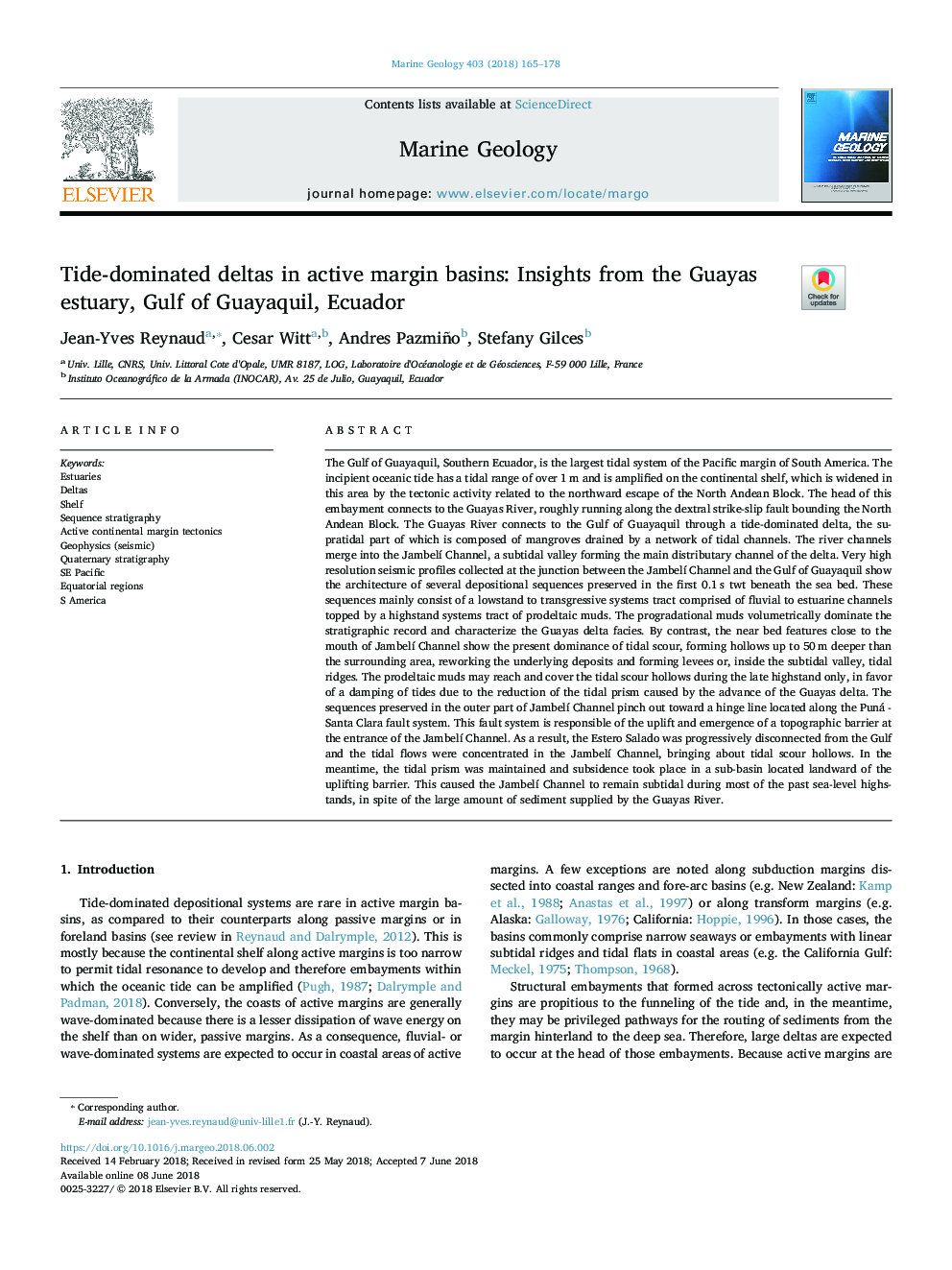| کد مقاله | کد نشریه | سال انتشار | مقاله انگلیسی | نسخه تمام متن |
|---|---|---|---|---|
| 8911927 | 1639049 | 2018 | 14 صفحه PDF | دانلود رایگان |
عنوان انگلیسی مقاله ISI
Tide-dominated deltas in active margin basins: Insights from the Guayas estuary, Gulf of Guayaquil, Ecuador
ترجمه فارسی عنوان
دلتاهای غرق در غار در حوضه های حاشیه فعال: بینش از مرز گویا، خلیج گویاکیل، اکوادور
دانلود مقاله + سفارش ترجمه
دانلود مقاله ISI انگلیسی
رایگان برای ایرانیان
کلمات کلیدی
موضوعات مرتبط
مهندسی و علوم پایه
علوم زمین و سیارات
ژئوشیمی و پترولوژی
چکیده انگلیسی
The Gulf of Guayaquil, Southern Ecuador, is the largest tidal system of the Pacific margin of South America. The incipient oceanic tide has a tidal range of over 1â¯m and is amplified on the continental shelf, which is widened in this area by the tectonic activity related to the northward escape of the North Andean Block. The head of this embayment connects to the Guayas River, roughly running along the dextral strike-slip fault bounding the North Andean Block. The Guayas River connects to the Gulf of Guayaquil through a tide-dominated delta, the supratidal part of which is composed of mangroves drained by a network of tidal channels. The river channels merge into the Jambelà Channel, a subtidal valley forming the main distributary channel of the delta. Very high resolution seismic profiles collected at the junction between the Jambelà Channel and the Gulf of Guayaquil show the architecture of several depositional sequences preserved in the first 0.1â¯s twt beneath the sea bed. These sequences mainly consist of a lowstand to transgressive systems tract comprised of fluvial to estuarine channels topped by a highstand systems tract of prodeltaic muds. The progradational muds volumetrically dominate the stratigraphic record and characterize the Guayas delta facies. By contrast, the near bed features close to the mouth of Jambelà Channel show the present dominance of tidal scour, forming hollows up to 50â¯m deeper than the surrounding area, reworking the underlying deposits and forming levees or, inside the subtidal valley, tidal ridges. The prodeltaic muds may reach and cover the tidal scour hollows during the late highstand only, in favor of a damping of tides due to the reduction of the tidal prism caused by the advance of the Guayas delta. The sequences preserved in the outer part of Jambelà Channel pinch out toward a hinge line located along the Puná - Santa Clara fault system. This fault system is responsible of the uplift and emergence of a topographic barrier at the entrance of the Jambelà Channel. As a result, the Estero Salado was progressively disconnected from the Gulf and the tidal flows were concentrated in the Jambelà Channel, bringing about tidal scour hollows. In the meantime, the tidal prism was maintained and subsidence took place in a sub-basin located landward of the uplifting barrier. This caused the Jambelà Channel to remain subtidal during most of the past sea-level highstands, in spite of the large amount of sediment supplied by the Guayas River.
ناشر
Database: Elsevier - ScienceDirect (ساینس دایرکت)
Journal: Marine Geology - Volume 403, 1 September 2018, Pages 165-178
Journal: Marine Geology - Volume 403, 1 September 2018, Pages 165-178
نویسندگان
Jean-Yves Reynaud, Cesar Witt, Andres Pazmiño, Stefany Gilces,
